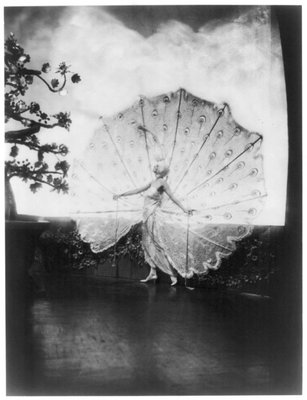The final part of a three part series in which The Art of Dress explores the influence of one of the world’s most beautiful birds, the peacock, and one of its “Golden” ages of influence on fashion from 1894-1920.
PART THREE: Peacock Personified
The peacock’s association with romantic and exotic fantasy gave it new meaning after 1910 in the realm of costume design for stage and screen. As the print media expanded and the new art of film developed, actresses, singers, and dancers became idolized stars. Influenced by the overwhelming success of Sergei Diaghilev’s dazzling Ballet Russes, producers favored plays and films with exotic settings for eager audiences. Stars embodied the peacock in form and spirit, overcoming long-held theatrical superstitions that its feathers possessed the “evil-eye” and brought bad luck. The male bird became a symbol of exotic femininity and fantastical extravagance.

Ruth St. Denis posed for her role in Legend of the Peacock on the grounds of Ravinia Park, Chicago, Illinois, July 27th, 1914.
Dubbed the “Soul of the East” by Vanity Fair, American dancer Ruth St. Denis (1879-1968) was known for her exotic costumes and choreography. St. Denis embodies the peacock in the premiere performance of Legend of the Peacock—choreographed by St. Denis with music by Edmond Roth. The dance, based on an Indian legend in which a woman’s excessive pride turns her into a peacock, would remain a staple of St. Denis’ performance repertoire well into the 1920s.

Reprinted courtesy of Condé Nast
Haute couture model turned Ziegfeld Follies showgirl, Dolores was admired for her beauty and statuesque frame, which she utilized to full effect in her stunning portrayal of the white peacock. In her book Allure, Diane Vreeland remembered the dynamism of Ziegfeld’s showgirls, especially Dolores: “I remember his girls so vividly. Dolores was the greatest of them—a totally Gothic English beauty. She was very highly paid just to walk across the stage—and the whole place would go to pieces.” The “White Peacock”costume was designed by couturière Lucile and still exists today in the collection of the Museum of the City of New York.

Gloria Swanson (1899-1983) brought fashion, fantasy, and peacocks to the silver screen in the Teens with three consecutive Paramount films directed by Cecil B. Demille, beginning in 1919 with Don’t Change Your Husband, where she carried a peacock feather fan. In Male and Female that same year, she wore a spectacular peacock costume designed by Mitchelle Leisen. In her next film, Why Change Your Wife (1920), Swanson wore an evening gown decorated with peacock feathers. As one critic noted, “Three great pictures in which the wearer of the many-eyed plumes has leaped to fame—is it any wonder that Gloria Swanson says peacock feathers are lucky.”


in Male and Female, 1919, photo via Paramount Pictures.
In Male and Female, Swanson’s character chooses death over marriage to a ruthless tyrant played by Thomas Meighan. Swanson remembered the unforgettable costume in her autobiography: “The greatest risk for me was the sheer weight of my costume. Two maids had to help me carry it when I was not on set. The gown was made entirely of pearls and white beads—enough to fill a bushel basket—and the towering headdress was made of white peacock feathers, which were a source of great consternation in the wardrobe department, for many people thought they brought bad luck.” A long-established superstition in theater and life, held that the “eyes’ of the peacock feather were long associated with the “evil eye” and the devil.

1920, photographer unknown, image via Selznick Pictures.


Please I would like to use the dress worn by Dolores as my project work in school but I’m confused about how to make the feathers spread
LikeLike
Dear Zachary,
Is there any record of what happened to Ms Swanson’s Peacock dress?
LikeLike